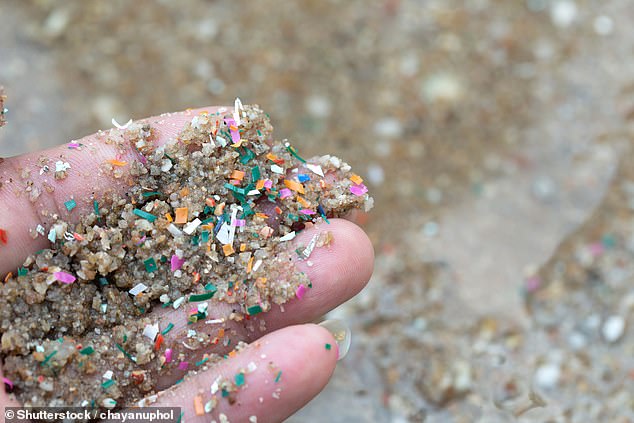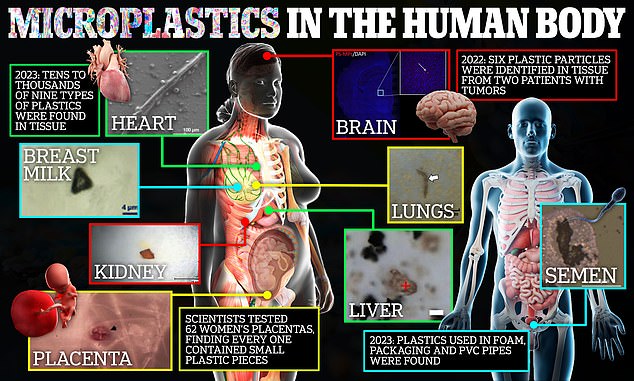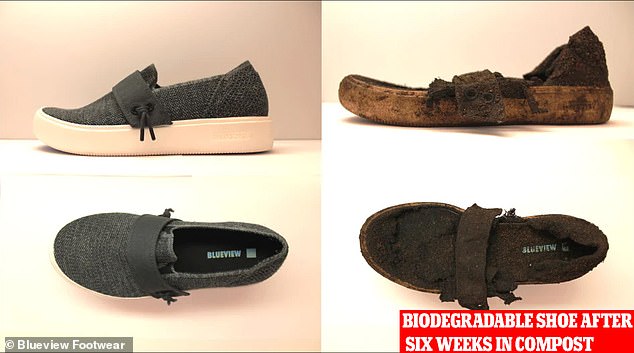Scientists create plant-based plastic that doesn’t create cancer-causing microplastics because 97% of it breaks down in the environment
A new plastic that doesn’t break down into cancer-causing microplastics could be the answer to the rise of the toxic material found in our food, water and bodies.
Researchers at the University of California (UC), San Diego developed a plant-based polymer – also called bioplastic – from algae and found that 97 percent of it biodegraded in landfills over the course of 200 days.
This was compared to just 35 percent of traditional plastic breaking down in the same time frame.
The team also revealed that they are already working with an engineering group to use bioplastics that could lead to the production of mobile phone cases.
Researchers revealed that 97 percent of plant-based polymers called TPU-FC1 biodegraded after 200 days – compared to EVA, which is petroleum-based plastics

Researchers have developed an alternative to plastics that creates microplastics (photo above). The new discovery uses plant-based polymers that biodegrade within six months
Microplastics are small fragments of common plastic products found in our blood vessels, lungs and placentas that take 100 to 1,000 years to break down.
“We are only beginning to understand the implications of microplastics,” said Michael Burkart, professor of chemistry and biochemistry at UC San Diego and co-author of the study.
‘We try to find replacements for materials that already exist and ensure that these replacements are biodegradable at the end of their life rather than ending up in the environment. That’s not easy.’
Microplastics have received a lot of attention recently due to their prevalence and abundance in our daily lives.
The tiny particles have also been found in almost every part of the world – from the deepest place on Earth, the Mariana Trench to the top of Mount Everest.
In 2016, three UC San Diego professors attempted to turn algae into fuel, which turned into a quest to create the first biodegradable shoe.

Nanoplastics are found in arteries, lungs and placentas and can take between 100 and 1000 years to break down

In 2022, the first biodegradable shoe was made from fossil algae oil
The team succeeded in creating an algae-based polymer called TPU-FC1 and in 2022 launched the first biodegradable polyurethane shoe soles made from fossil algae oil.
Plastics are made from petroleum, which comes from algae, making it the best option for future biodegradable products.
For the latest research, the team ground the plant-based polymers into microparticles and used three measuring instruments to test whether the microbes in the compost break down the material.
They used a respirometer that tested how much carbon dioxide (CO2) was released as the material decomposed and found it was 100 percent in line with the industry standard for biodegradability.
The industry standard for biodegradability is that the product must disintegrate by at least 90 percent in less than six months.
The team then compared the algae-based microplastics with petroleum-based microplastics using a water flotation method.
Because plastics float, they can be easily removed from the water surface. The researchers checked both types of plastic at 90- and 200-day intervals, but by the end of the test, almost all of the petroleum-based microplastics had been recovered.
Meanwhile, the researchers recovered only 32 percent of plant-based microplastics after 90 days and three percent after 200 days, meaning 97 percent of the test material had biodegraded.
The final step was to detect the presence of monomers – the tiny particles that make up the plastic – to verify that the polymer had broken down into the original plant materials used to make it.
“This material is the first plastic shown not to create microplastics the way we use it,” said Stephen Mayfield, co-author of the paper, professor in the School of Biological Sciences and co-founder of Algenesis.
“This is more than just a sustainable end-of-product lifecycle solution and our overflowing landfills. This is actually plastic that doesn’t make us sick.’
The discovery marks an important step toward eliminating the amount of potentially toxic microplastics that can cause heart attacks, certain cancers, fertility problems and dementia.
Some researchers and public health experts have also raised concerns that exposure to microplastics could lead to babies being born underweight.
Recent studies have found that the average liter of bottled water purchased at the store contains more than 240,000 nanoplastics, while most meat and plant-based alternatives contain tiny plastics linked to cancer.
Scientists have warned that it will take some time to transition to making the new material because existing production equipment is only built for traditional plastic.
“When we started this work, we were told it was impossible,” Burkart said.
‘Now we see a different reality. There is still a lot of work to be done, but we want to give people hope. It is possible.’
